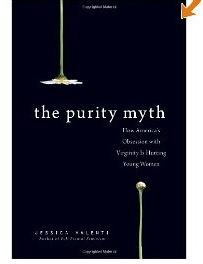 Jessica Valenti’s The Purity Myth is a book that, were it read by a broader audience, would be best described as polarizing. Given the number of positive reviews on Amazon, I’m going to wager that few in the Purity movement have read the book- or else are very restrained in their desire to review. I myself have struggled with how much of my own viewpoints to put in this review, mainly because I agree with the case Valenti is making, and that is an emotional reaction. I’ll be honest, this one fired me up, and angered my inner activist.
Jessica Valenti’s The Purity Myth is a book that, were it read by a broader audience, would be best described as polarizing. Given the number of positive reviews on Amazon, I’m going to wager that few in the Purity movement have read the book- or else are very restrained in their desire to review. I myself have struggled with how much of my own viewpoints to put in this review, mainly because I agree with the case Valenti is making, and that is an emotional reaction. I’ll be honest, this one fired me up, and angered my inner activist.
At the heart of The Purity Myth is an examination of what is called the Purity movement and it’s impact on women and society’s views on women.
The Purity Myth examines the impact of the growing societal obsession (by some) with chastity and virginity on young women. In fact, the book examines how our hyper-sexualized culture in general places a woman’s (or girl’s) worth on her sexuality- she’s either chaste and “good” or a girl gone wild and “bad”.
Valenti examines the impact of morality based on sexual behavior and proffers this analysis in a social, cultural, and historical context.
For those unfamiliar with the Purity movement, it is a program popular in mostly evangelical christian circles. The premise in a nutshell is that a girl’s most prized possession, her most character defining trait, is her virginity. At Purity Balls, girls dress up in ball gowns and, accompanied by their fathers, attend a prom-like dinner dance. At this point, the fathers promise to be guardians of their daughter’s chastity until they give her in marriage to a worthy man. Yeah.
In theory, the Purity movement seems to be a nice idea. But what Valenti points out is that it is an outward sign of an overarching ideology that somehow women and girls are not competent enough to make decisions on their own about their sexuality, and that a status of virgin is a better determinant of morality than say, our intelligence, empathy, kindness and any other number of characteristics by which we generally define morality. Valenti goes on to explore how the Purity movement is really a mechanism for keeping women second class citizens, with impacts more far-reaching than they initially appear.
I’m glad I read The Purity Myth. While I thought at times Valenti might be a bit far-reaching in some of her conclusions, and I would like more time to examine the context of some of the sources she cites (as I like to do with anything controversial I read) I believe that she is on to a fundamental truth. Tying up a woman’s worth with whether or not she is a virgin- of which Valenti points out there is no standard accepted definition- is detrimental to women and girls. We are so much more than this, and should be judged on our character, not whether or not we meet some arbitrary definition of a virgin.
Although published in 2009, I believe The Purity Myth is particularly relevant to our current political climate and the women’s issues that are, appallingly in 2012, up for debate in this election. If you have any interest in or concerns about the future of women’s rights in this country, I encourage you to read The Purity Myth.
- Tags: Jessica Valenti, morality, Purity Myth, women's rights